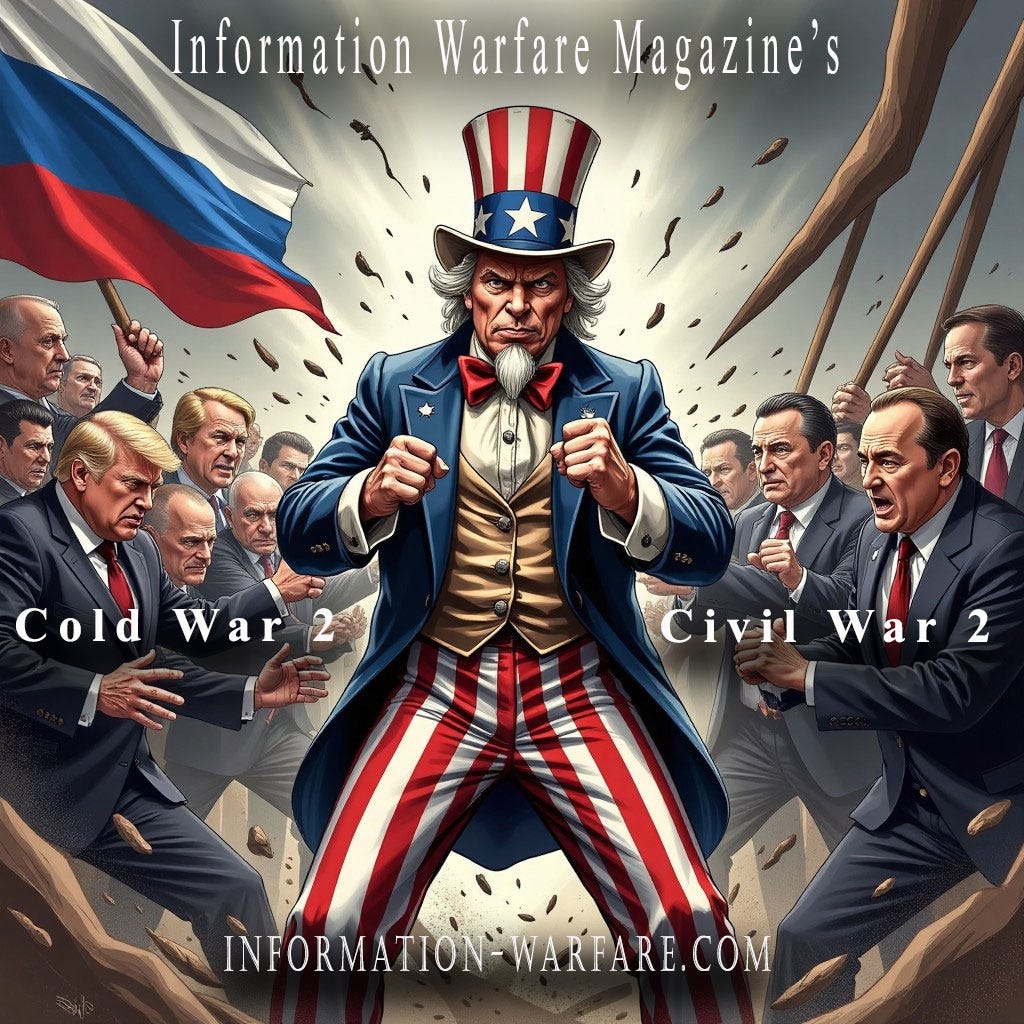Can America Defend Itself?
The Dual Front Wars of the 21st Century
Can America withstand both Cold War 2 and Civil War 2 simultaneously?
The question is no longer theoretical. It’s here.
The United States stands at a crossroads unlike any other in its history, faced with a relentless onslaught from external powers and an equally corrosive ideological battle from within.
Conflict 1: Cold War 2
“Without a sovereign, strong Russia, no stable world order is possible.” — Vladimir Putin
Russia has re-emerged as a formidable adversary on the global stage, reasserting its influence through geopolitical, economic, and ideological warfare. Its ambitions extend beyond mere regional dominance; Putin seeks to destabilize Western democracies and assert Russia as a counterbalance to U.S. hegemony.
The strategic push into the Arctic, manipulation of energy markets, and exploitation of fractured alliances—particularly within NATO—underscore Russia’s strategy. By sowing discord within Western nations, especially the United States, Putin aims to weaken democratic institutions and undermine collective security frameworks.
A critical factor in this equation is Donald Trump’s presidency. Whether advertently or inadvertently, Trump’s actions have played directly into Putin’s strategic aims. His isolationist policies, disregard for NATO, and frequent alienation of allies have left the United States increasingly isolated on the world stage. By undermining international alliances and engaging in trade wars with long-standing partners, Trump has made each of these nations weaker while also weakening the U.S. itself.
In Putin’s eyes, Trump’s actions are the dream scenario—a divided and isolated America, where allies are fractured, and global consensus is difficult to achieve. This weakening of Western alliances allows Russia to assert itself with minimal opposition, solidifying its influence in geopolitically strategic areas such as the Arctic and Eastern Europe.
Russian interference in American politics is not just a matter of past election meddling. It is a continuous, multifaceted campaign aimed at fracturing American society, deepening political polarization, and destabilizing institutions.
The exploitation of economic vulnerabilities and technological dependencies has become a cornerstone of modern Russian warfare. With Trump’s erosion of alliances and internal chaos within the U.S., Russia has capitalized on a divided West, projecting strength where America shows weakness.
Conflict 2: Civil War 2
“If we are to have another contest in the future of our national existence, the dividing line will be between patriotism and intelligence on the one side, and superstition, ambition, and ignorance on the other.” — Ulysses S. Grant
Internally, America is battling an ideological war fueled by corporate power, technological upheaval, and authoritarian ambitions. The conflict is not just political; it encompasses economic disparity, cultural fragmentation, and a fundamental clash of visions for the nation’s future.
Movements such as the Dark Enlightenment and Project 2025 aim to dismantle democratic institutions and replace them with corporatized, tech-driven governance. Figures like Peter Thiel, Elon Musk, and other influential billionaires are actively investing in models that prioritize technological control over democratic accountability.
The rise of network states, Freedom Cities, and privatized governance structures reflects a broader disillusionment with traditional government. This internal fracturing is amplified by Silicon Valley’s ambitions to establish autonomous, decentralized systems that operate beyond the reach of democratic oversight.
The undermining of federal institutions through schemes such as Project 2025 threatens to centralize power under a narrow ideological framework, stripping away democratic safeguards.
The Intersection of Both Wars
What makes America’s current struggle unprecedented is the intersection of these two battles. While Russia works to destabilize the U.S. from the outside, internal actors—driven by greed, ambition, and ideological zeal—undermine the foundations of democracy from within.
The weakening of NATO and the erosion of democratic institutions within America are mutually reinforcing. As America’s global credibility diminishes, domestic actors feel emboldened to pursue their own agendas, free from traditional checks and balances.
Moreover, the rise of privatized governance systems and autonomous technological states threatens to create a fractured landscape of corporate-controlled enclaves that do not answer to democratic oversight.
Grant’s Warning and America’s Existential Crisis
General Ulysses S. Grant’s warning about a future conflict was rooted in his experiences during the Civil War—a time of immense national division and ideological strife. His words echo today as America faces not only a hostile foreign power but also a concerted internal effort to redefine governance along corporate and authoritarian lines.
Grant’s prophecy is playing out in real time. America’s new dividing line is being drawn between those who uphold democratic ideals and those who seek to dismantle them for power and profit. The conflict is not merely political; it is philosophical and existential.
Can America Defend Itself?
America’s dual wars demand a cohesive and strategic response—one that acknowledges the interconnectedness of external and internal threats. However, the nation remains fractured, its political system increasingly paralyzed by polarization and corruption.
To counter Cold War 2, America must rebuild its alliances, particularly NATO, and strengthen its defenses against cyber warfare and economic manipulation. But these efforts will mean little if the nation remains internally divided.
To survive Civil War 2, America must address the underlying social, economic, and technological factors that fuel division. It must confront the ambitions of those who seek to replace democracy with corporate governance and authoritarian control.
The rise of corporate feudalism through the likes of Project 2025 and network state initiatives highlights a broader rejection of democracy by those who view it as inefficient and incompatible with their own interests.
The Ultimate Question
The ultimate question remains:
Can America defend itself against both external and internal threats simultaneously, or will it collapse under the weight of its own contradictions?


